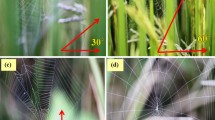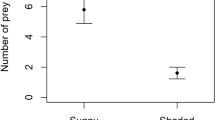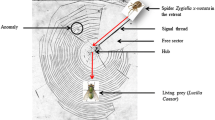Summary
The pattern of prey utilization of the orb-weaving spiderAraneus pinguis was studies by comparing between arthropods restrained in the empty webs (spiders were removed) and those unattacked in the intact webs (spiders were not removed). The number of arthropods was larger in the empty webs than in the intact webs. In the empty webs, web area, mesh width, number of radii, and signal thread length were presumed to affect the number of arthropods left in a single web. As for the intact webs, web area, mesh width, and web-exposure time were important factors. In the empty webs, the density of arthropods decreased away from the hub. On the other hand, the density of unattacked arthropods in the intact webs was the same throughout the web.
Arthropods in the empty webs were larger than those in the intact webs. The upper limit in size of unattacked arthropods increased along with the distance from the hub in the intact webs, but not in the empty webs. These results indicate increase in the minimum size of eaten arthropods increased in the former. This positive sizedistance relation may have resulted from the adaptive switching of spiders’ alternative foraging methods (i.e., the rapid attack at encounter and the later eating during web deconstruction) on the basis of the prey profitability.
Similar content being viewed by others
References
Barth, F. G. (1982) Spiders and vibratory signals: sensory reception and behavioral significance. 67–122. InP. N. Witt andJ. S. Rovner (eds)Spider communication: mechanisms and ecological significance. Princeton University Press, Princeton, N.J.
Craig, C. L. (1986) Orb-web visibility: the influence of insect flight behaviour and visual physiology on the evolution of web designs within the Araneoidea.Anim. Behav.,34: 54–68.
Harwood, R. H. (1974) Predatory behavior ofArgiope aurantia (Lucas).Am. Mid. Nat. 91: 130–139.
Klärner, D. andF. G. Barth (1982) Vibratory signals and prey capture in orb-weaving spiders (Zygiella x-notata, Nephila clavipes; Araneidae).J. Comp. Physiol. 148: 445–455.
Krebs, J. R. (1978) Optimal foraging: decision rules for predator. 23–63. InJ. R. Krebs andN. B. Davies (eds)Behavioural ecology: an evolutionary approach. Blackwell Scientific Publications Oxford.
Masters, W. M. and A. J. M. Moffat, (1983) A functional explanation of top-bottom asymmetry in vertical orbwebs.Anim. Behav. 31: 1043–1046.
Nentwig, W. (1982) Why do only certain insects escape from a spider’s web?Oecologia 53: 412–417.
Nentwig, W. (1985a) Top-bottom asymmetry in vertical orb web in spiders.Oecologia 67: 111–112.
Nentwig, W. (1985b) Prey analysis of four species of tropical orb-weaving spiders (Araneae: Araneidae) and a comparison with araneids of the temperate zone.Oecologia 66: 580–594.
Orians, G. H. andN. E. Pearson (1979) On the theory of central place foraging. 155–177. InD. J. Horn, G. R. Stairs, andR. D. Mitchell (eds)Analysis of ecological systems. Ohio University Press, Columbus.
Peakall, D. B. (1971) Conservation of web proteins in the spider,Araneus diadematus.J. Exp. Zool. 176: 257–264.
Risch, P. (1977) Quantitative analysis of orb web patterns in four species of spiders.Behav. Genet. 7: 199–238.
Robinson, M. H. (1969) Predatory behavior ofArgiope argentata (Fabricius).Am. Zool. 9: 161–173.
Rypstra, A. (1982) Building a better insect trap: an experimental investigation of prey capture in a variety of spider webs.Oecologia 52: 31–36.
Schoener, T. W. (1971) Theory of feeding strategies.Ann. Rev. Ecol. Syst. 2: 369–404.
Schoener, T. W. (1979) Generality of the size-distance relation in models of optimal feeding.Am. Nat. 114: 902–914.
Stephens, D. W. andJ. R. Krebs (1986)Foraging theory. Princeton University Press, Princeton, N.J.
Witt, P. N. andC. F. Reed (1965) Spider-web building.Science 149: 1190–1197.
Author information
Authors and Affiliations
Rights and permissions
About this article
Cite this article
Endo, T. Patterns of prey utilization in a web of orb-weaving spiderAraneus pinguis (Karsch). Res Popul Ecol 30, 107–121 (1988). https://doi.org/10.1007/BF02512606
Issue Date:
DOI: https://doi.org/10.1007/BF02512606




